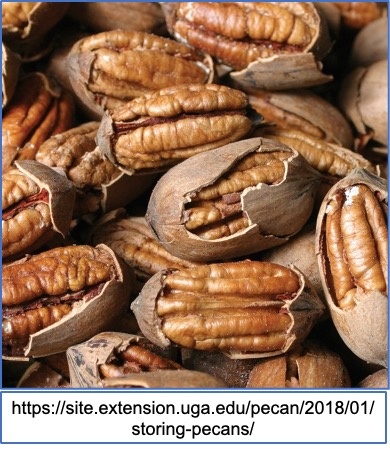Pecan Season in NC
go.ncsu.edu/readext?899526
en Español / em Português
El inglés es el idioma de control de esta página. En la medida en que haya algún conflicto entre la traducción al inglés y la traducción, el inglés prevalece.
Al hacer clic en el enlace de traducción se activa un servicio de traducción gratuito para convertir la página al español. Al igual que con cualquier traducción por Internet, la conversión no es sensible al contexto y puede que no traduzca el texto en su significado original. NC State Extension no garantiza la exactitud del texto traducido. Por favor, tenga en cuenta que algunas aplicaciones y/o servicios pueden no funcionar como se espera cuando se traducen.
Português
Inglês é o idioma de controle desta página. Na medida que haja algum conflito entre o texto original em Inglês e a tradução, o Inglês prevalece.
Ao clicar no link de tradução, um serviço gratuito de tradução será ativado para converter a página para o Português. Como em qualquer tradução pela internet, a conversão não é sensivel ao contexto e pode não ocorrer a tradução para o significado orginal. O serviço de Extensão da Carolina do Norte (NC State Extension) não garante a exatidão do texto traduzido. Por favor, observe que algumas funções ou serviços podem não funcionar como esperado após a tradução.
English
English is the controlling language of this page. To the extent there is any conflict between the English text and the translation, English controls.
Clicking on the translation link activates a free translation service to convert the page to Spanish. As with any Internet translation, the conversion is not context-sensitive and may not translate the text to its original meaning. NC State Extension does not guarantee the accuracy of the translated text. Please note that some applications and/or services may not function as expected when translated.
Collapse ▲Early November in North Carolina means it is time to watch out for falling pecans. It has been a difficult growing season, but these delicious nuts will soon be on your table, just in time for the holiday season. Let us briefly discuss how you can better manage pecans on your property and share a tasty recipe from the NC Pecan Growers Association.
For homeowners who have pecan trees growing in their yards, you probably understand the seasonal delight and challenges of living with pecans. Although pecan trees bear delicious nuts, they also shed limbs as a result of having weak wood. This shedding of limbs may also signal seasonal infestations of insect pests, which means routine yard maintenance to remove falling limbs and pecans is beneficial for pest control.
Pecan trees are also prone to alternate bearing of heavy loads of nuts during one year followed by fewer nuts the next. A fertilizer program can help reduce this issue and is best achieved by taking a soil test every 3-4 years. A soil test will help you monitor for soil pH imbalances and make recommendations for adjustments to elements like phosphorus that do not need yearly fertilizer applications. Yearly applications of nitrogen and potassium applied at a rate of 0.25 pound per inch of trunk diameter, measured at one foot above the ground, will encourage fruitfulness and aid in alleviating alternate bearing.
When applying fertilizer, simply broadcast the required amount of product in and around the base of the tree near the outer edge of the canopy. There is no need to dig special fertilizer holes and randomly space them around the tree. Trees do not have fertilizer radar and this practice is not necessary. Apply half of your nitrogen and potassium fertilizer in February, and then the remainder later in the year when the trees have finished flowering and small pecans are beginning to form.
Occasionally, homeowners will find fall webworms eating foliage in trees. While this may seem destructive, it is often times merely cosmetic and does little to harm the tree. Control is rarely needed, but if you must do something, then start by using a long pole to disturb webbing. This will expose the caterpillars feeding inside to predation from birds. Insecticide applications made to foliage near webbing may help with control. Spraying the webbing directly will have little effect, as it protects the caterpillars inside from coming into contact with your insecticide. As the caterpillars move to feed on the exposed foliage, this is when they will consume or come into contact with the insecticide.
Finally, when pecans do begin to fall, harvest them quickly from the ground. Pecans left on the ground after a few days will mold quickly due to excessive moisture from the soil. Dry freshly harvested pecans inside your home before you try to store them. This could be accomplished by laying them out in shallow boxes or hanging them in porous burlap bags. Pecans can be stored at 32-degree Fahrenheit for about a year or longer if frozen. Pecans will spoil if not stored properly.
Once you have harvested your pecans and removed the kernels, it is time to eat them. For those who need a little help, try this holiday favorite from the NC Pecan Growers Association.
Classic Pecan Pie
4 eggs
3/4 cup sugar
1/2 teaspoon salt
1 1/2 cups light corn syrup
1 tablespoon butter, melted
1 teaspoon vanilla
1 cup pecan halves
1 9-inch pie crust, unbaked
Preheat oven to 400 degrees F. Prepared pie shell.
Beat the eggs lightly and add the sugar, salt, corn syrup, cooled butter and vanilla; stir until mixed well. Spread the pecan halves on the bottom and cover with the filling. Place in the oven and immediately reduce the heat to 350 degrees F. Bake for 40-45 minutes or until the mixture is firm in the center. Cool before serving.
For more information on growing pecans or other home gardening information, please contact Daniel Simpson at 252-745-4121 or daniel_simpson@ncsu.edu.





